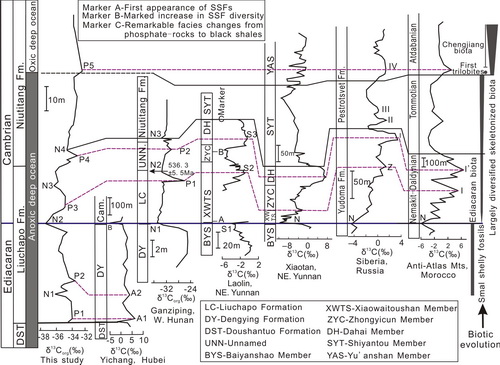Evolution from an anoxic to oxic deep ocean during the Ediacaran-Cambrian transition and implications for bioradiationUpdate time:05 11, 2012
Postdoctor WANG Jianguo and his teacher CHEN Daizhao present high-resolution carbon and sulfur isotopic data respectively for organic carbon and pyrite, and iron speciation data from the deep-water Liuchapo and Niutitang Formations on the Yangtze block, South China. The carbon isotopic data, together with biostratigraphic and radiometric dating, offer the compelling evidence for the placement of Ediacaran–Cambrian boundary within the Liuchapo Formation (chert succession), and for its correlation with shallow-water equivalents elsewhere. In this context, iron speciation and sulfur isotopic data further suggest a predominant anoxic and ferruginous deep ocean over the transitional time until the middle Early Cambrian (Atdabanian or Stage 3) when the deep ocean was rapidly oxygenated. Coincidently, during this interval, large-body metazoans (i.e., sponges) abruptly appeared in the deep ocean, which was temporally associated with the highly diversified large-body skeletonized animals (i.e., Chengjiang Biota) which colonized in shallow-water niches particularly in southwestern China. This scenario suggests a causal link between deep oceanic oxygenation and the explosive diversification of large-body skeletonized organisms in the Early Cambrian.
Fig. 1. Vertical variations in δ13Corg, δ34Spy and Fe speciation across the E–C boundary succession (from Liuchapo to Niutitang Formations) at Longbizui section, western Hunan, South China. (Image by WANG)
Fig. 2. Carbon isotopic variations across the E–C transition at Longbizui, Guzhang County, western Hunan, and their correlation with those at other places. (Image by WANG) Wang et al. Evolution from an anoxic to oxic deep ocean during the Ediacaran-Cambrian transition and implications for bioradiation. Chemical Geology. 2012, 306-307: 129-138 (Download Here)
|
Contact
Related Articles
Reference
|
-
SIMSSecondary Ion Mass Spectrometer Laboratory
-
MC-ICPMSMultiple-collector ICPMS Laboratory
-
EM & TEMElectron Microprobe and Transmission Electron Microscope Laboratory
-
SISolid Isotope Laboratory
-
StIStable Isotope Laboratory
-
RMPARock-Mineral Preparation and Analysis
-
AAH40Ar/39Ar & (U-Th)/He Laboratory
-
EMLElectron Microscopy Laboratory
-
USCLUranium Series Chronology Laboratory
-
SASeismic Array Laboratory
-
SEELaboratory of Space Environment Exploration Laboratory
-
PGPaleomagnetism and Geochronology Laboratory
-
BioMNSFrance-China Bio-mineralization and Nano-structure Laboratory

 Print
Print Close
Close

